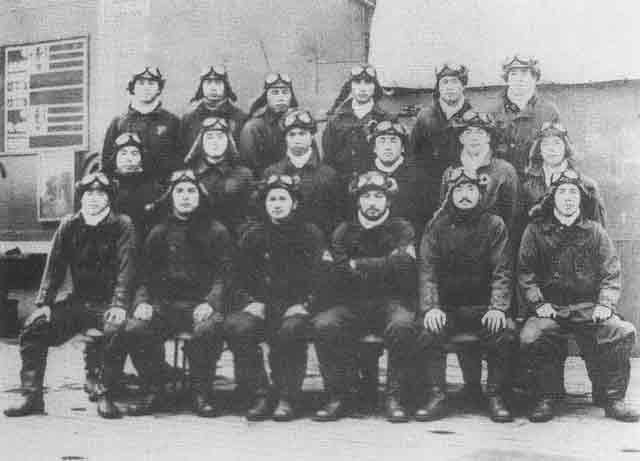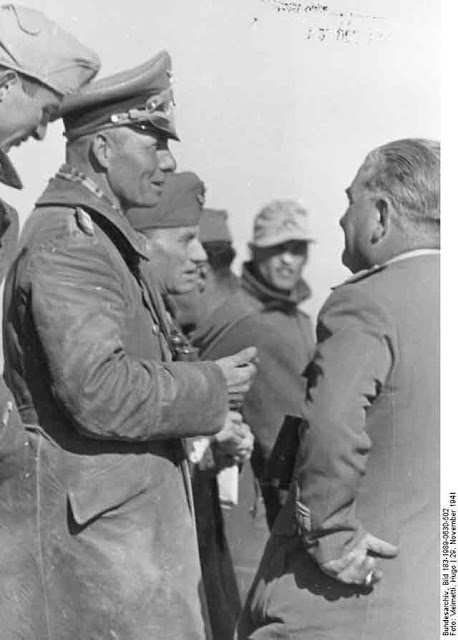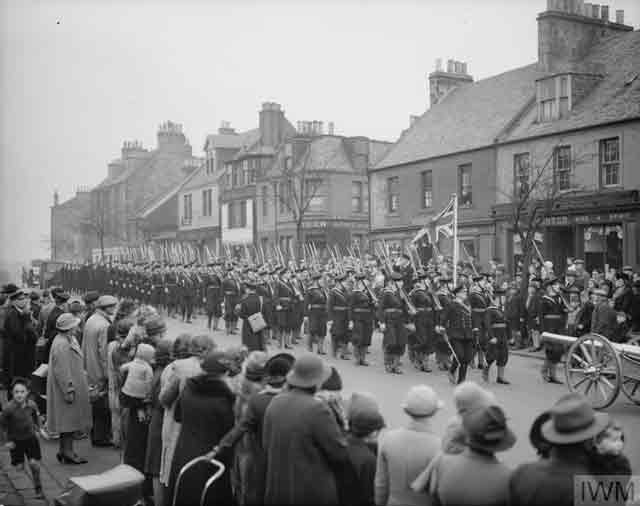Saturday 6 December 1941
 |
| Aboard Japanese aircraft carrier Kaga northwest of Hawaii, pilots and aircrew receive a final briefing on 6 December 1941. Note the map drawn on the deck. |
 |
| Japanese aircraft carrier Akagi, battleship Hiei, and battleship Kirishima on their way to Hawaii, on or about 6 December 1941. |
 |
| "Motorcyclists of 59th Battalion, Reconnaissance Corps at Ballykinlar in Northern Ireland, 6 December 1941." © IWM (H 16470). |
 |
| British 1281-ton freighter SS Greenland (note name on the bow) hits a mine and sinks after striking a German mine while traveling from London to Grangemouth. There are 8-10 casualties, no survivors. |
 |
| Conductor Hermann Abendroth of the Paris Conservatory arrives for a Mozart concert, 6 December 1941 (Fulgur (Pala), Federal Archive Picture 183-10820-0041). |
 |
| Dive-bomber Pilots aboard Zuikaku posing for a ceremonial last portrait before their Pearl Harbor attack, 6 December 1941. |
British submarine HMS Perseus strikes a mine and sinks five miles off the coast of the Greek island of Cephalonia. It comes to rest in 171 feet of water. All 61 men aboard immediately perish except for four men who manage to exit through an escape hatch. Only one of the men, a passenger named John Capes, successfully reaches the surface. Badly afflicted with the bends, Capes swims to the island, where he is found on the beach by Greek fishermen. Capes spends the next 18 months hiding on the island from its occupying Italian troops before being smuggled to Alexandria. While Capes is awarded a medal for his heroism, many doubt his story, and he passes away in obscurity in 1985. In 1997, a diving party finds the Perseus and verifies every aspect of Capes' story.
December 1941
December 1, 1941: Hitler Fires von Rundstedt
December 2, 1941: Climb Mount Niitaka
December 3, 1941: Hints of Trouble in the Pacific
December 4, 1941: Soviets Plan Counteroffensive
December 5, 1941: Soviets Counterattack at Kalinin
December 6, 1941: Soviet Counterattack at Moscow Broadens
December 7, 1941: Japan Attacks Pearl Harbor
December 8, 1941: US Enters World War II
December 9, 1941: German Retreat At Moscow
December 10, 1941: HMS Prince of Wales and Repulse Sunk
December 11, 1941: Hitler Declares War on the US
December 12, 1941: Japanese in Burma
December 13, 1941: Battle of Cape Bon
December 14, 1941: Hitler Forbids Withdrawals
December 15, 1941: The Liepaja Massacre
December 16, 1941: Japan Invades Borneo
December 17, 1941: US Military Shakeup
December 18, 1941: Hitler Lays Down the Law
December 19, 1941: Brauchitsch Goes Home
December 20, 1941: Flying Tigers in Action
December 21, 1941: The Bogdanovka Massacre
December 22, 1941: Major Japanese Landings North of Manila
December 23, 1941: Wake Island Falls to Japan
December 24, 1941: Atrocities in Hong Kong
December 25, 1941: Japan Takes Hong Kong
December 26, 1941: Soviets Land in the Crimea
December 27, 1941: Commandos Raid Norway
December 28, 1941: Operation Anthropoid Begins
December 29, 1941: Soviet Landings at Feodosia
December 30, 1941: Race for Bataan
December 31, 1941: Nimitz in Charge
2020
 |
| Author Dale Carnegie ("How to Win Friends and Influence People") arrives in New York City after flying from Toronto on a Trans Canada Air Lines flight, 6 December 1941. |
December 1941
December 1, 1941: Hitler Fires von Rundstedt
December 2, 1941: Climb Mount Niitaka
December 3, 1941: Hints of Trouble in the Pacific
December 4, 1941: Soviets Plan Counteroffensive
December 5, 1941: Soviets Counterattack at Kalinin
December 6, 1941: Soviet Counterattack at Moscow Broadens
December 7, 1941: Japan Attacks Pearl Harbor
December 8, 1941: US Enters World War II
December 9, 1941: German Retreat At Moscow
December 10, 1941: HMS Prince of Wales and Repulse Sunk
December 11, 1941: Hitler Declares War on the US
December 12, 1941: Japanese in Burma
December 13, 1941: Battle of Cape Bon
December 14, 1941: Hitler Forbids Withdrawals
December 15, 1941: The Liepaja Massacre
December 16, 1941: Japan Invades Borneo
December 17, 1941: US Military Shakeup
December 18, 1941: Hitler Lays Down the Law
December 19, 1941: Brauchitsch Goes Home
December 20, 1941: Flying Tigers in Action
December 21, 1941: The Bogdanovka Massacre
December 22, 1941: Major Japanese Landings North of Manila
December 23, 1941: Wake Island Falls to Japan
December 24, 1941: Atrocities in Hong Kong
December 25, 1941: Japan Takes Hong Kong
December 26, 1941: Soviets Land in the Crimea
December 27, 1941: Commandos Raid Norway
December 28, 1941: Operation Anthropoid Begins
December 29, 1941: Soviet Landings at Feodosia
December 30, 1941: Race for Bataan
December 31, 1941: Nimitz in Charge
2020










